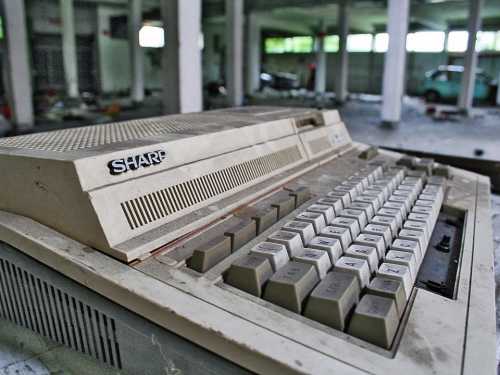
Sharp is one of the most famous Japanese companies in the history of consumer electronics. Over the century of its existence, it has gone an amazing way from the production of mechanical pencils to the creation of advanced LCD displays. In many countries, Sharp equipment was considered a benchmark of quality, and in Japan itself, the company has long been a symbol of technological innovation. However, in 2016, Sharp lost its independence, becoming part of the Taiwanese Foxconn. How did this happen and what is happening to the company now?
How it all began
Sharp founder Tokuji Hayakawa was born in 1893 in Tokyo to a furniture manufacturer. His childhood was difficult: due to health problems, his mother could not take care of him, and the boy was given up for adoption. Life in the new family did not become easier – the cruel treatment of his stepmother forced him to drop out of school in the second grade and start working. Fate smiled on eight-year-old Tokuji when an elderly woman helped him to become an apprentice to a strict but fair master metalworker.
After seven years of metalworking training, in April 1912, Tokuji Hayakawa created his first invention, the innovative Tokubijo belt buckle. The buckle's unique feature was that it did not require additional holes to be drilled in the belt. He received his first industrial patent for this invention. The buckle's success allowed the young craftsman to open his own metalworking workshop in Tokyo – and so began the history of Sharp.
In 1915, fate led Hayakawa to an invention that would define the future of his company. Having received an order for metal parts for a mechanical pencil, he discovered many flaws in the design and decided to create his own improved version. Thus appeared the “Ever-Ready Sharp Pencil”. The success of this invention was so significant that its name – Sharp – later became the name of the entire company and turned into a world-famous brand.
In 1923, he opened a 990-square-meter factory, employing 200 people. However, on September 1, 1923, tragedy struck with the devastating Kanto earthquake. Although the initial tremors did not destroy the factory, fires that broke out later destroyed the entire production. In this disaster, Hayakawa lost his wife and two children.
The era of radio receivers
After the tragedy, Hayakawa decided to start over in Osaka. He demonstrated exceptional business ethics, transferring the surviving equipment and patent rights to his distributor, to whom he owed money for unfulfilled orders, and helping to set up pencil production at the new location.
In 1924, Hayakawa founded a new company in Osaka, Hayakawa Metal Laboratories, which soon began to develop a completely new direction – the production of radio receivers. Despite a complete lack of experience in electronics, Hayakawa bought an imported radio receiver, disassembled it and, using the reverse engineering method, created his own model. In 1925, the company released its first crystal radio receiver, called Sharp. The device cost only three and a half yen – much cheaper than imported analogues.
In the following years, the company improved its technology, moving from simple crystal receivers to more sophisticated vacuum tube models. The new Sharp Dyne series, which operated from the mains, was a real breakthrough. By 1939, sales reached 130,000 units per year.
In 1942, the company changed its name to Hayakawa Electric Company and expanded its product range to include radios for aircraft and military use. It was the radio business that helped the company survive the difficult war and post-war years, largely due to large orders from the US Army during the Korean War.
Entering the TV and home appliance market
The next important stage in the company's history began in 1951, when Sharp entered into a licensing agreement with the American RCA to manufacture televisions in Japan. By the end of 1952, Sharp had produced its first batch of TVs, the TV3-14T model. However, the price of 175,000 yen made them unaffordable for most Japanese people – the average employee at that time received 5,400 yen per month.
In 1953, Sharp became the first Japanese company to mass-produce televisions. To boost sales, Hayakawa made a revolutionary decision at the time: he offered free maintenance on all of his equipment. This strategy proved successful, with monthly sales increasing to 500 units.
Hayakawa Electric began to expand its product range. In 1962, the company produced Japan's first microwave oven, the R-10, and the country's first solar-powered consumer electronics device, a transistor radio. The company maintained a leading position in solar cell production until the 1990s.
In 1960, inspired by the prospects of the semiconductor industry, the company created a team to develop logic circuits and manufacture computers. However, the Japanese government refused to provide government support, and Hayakawa decided to focus on the production of complex but non-programmable consumer electronics: receipt printers, cash registers and calculators.
In 1964, the company began a real revolution in the calculator industry: the CS-10A Compet model became one of the first fully transistorized calculators in the world. Despite the high price (equivalent to 15,000 modern dollars), all 300 of the devices were sold out in a matter of months. And a few years later, Sharp introduced the first calculator based on integrated circuits, which significantly reduced the price and size of the device.
The Golden Age of Sharp
In 1970, the company became one of the largest manufacturers of consumer electronics. At the same time, Hayakawa Electric Co. Ltd officially changed its name to Sharp. With this renaming, the company paid tribute to its first successful invention, the mechanical pencil, but most importantly, the new name was supposed to reflect the desire for innovation, especially in the field of new electronic technologies and semiconductors. In the same year, founder Hayakawa stepped down as president of the company. Akira Saeki became the new head.
In the 1970s, Sharp made a breakthrough in the production of audio equipment. The company was one of the first to mass-produce cassette tape recorders, constantly adding innovative features: a detachable wireless microphone in the GT-8M model, an automatic cassette track search system (APSS), a dynamic noise reduction system. In 1978, Sharp introduced the world's first two-cassette stereo tape recorder, the GF-555.
Sharp also remained an innovator in television technology. In 1978, the company was the first in the world to release a TV with the “picture-in-picture” (PiP) function, which allowed watching two programs at the same time. Later, unique combination devices appeared – for example, a radio with a built-in TV.
In the early 1980s, the company released a series of portable music systems with a vertical vinyl player, developed an original design of a two-cassette mechanism “TWIN”, where the cassettes were located side by side on the same axis. A special brand Optonica was created to produce high-quality Hi-Fi equipment.
In 1983, Sharp created a unique product in collaboration with Nintendo – the C1 NES TV with a built-in game console. This device became a real find for video game fans and is today highly valued by collectors of game consoles. By the end of the 1980s, Sharp produced hundreds of models of various equipment, carefully adapting them to the needs of different countries.
First problems
In the early 1990s, Japan faced an economic crisis. During the 1980s, the country had experienced an incredible rise in real estate and stock prices—a phenomenon that economists called the “Japanese bubble.” When the bubble burst, the country’s economy was plunged into a deep crisis: the yen’s value skyrocketed, making Japanese goods expensive on the world market, and domestic demand fell sharply.
In these conditions, Sharp, like other Japanese electronics manufacturers, faced serious problems. Cheap imported goods began to displace the company's traditional products – fax machines, calculators and microwave ovens. Trying to find a way out of the situation, Sharp began to develop new, technologically more complex products. Some of them became successful.
In 1991, Sharp revolutionized the world of televisions by introducing the first wall-mounted TV, the 9E-H series. The model was equipped with a color TFT LCD screen with a diagonal of 8.6 inches – the largest at that time. Another successful product was the Viewcam video camera – in 1992 it captured 20% of the Japanese market. However, other new products, such as the Wizard electronic organizer, although they gained popularity in their niche, did not become a mass product capable of solving the company's financial problems. And in the oversaturated laptop market, competition was so high that profits were minimal.
By 1998, the situation had become critical, with the company's net profit falling to 24.8 billion yen, just 1.4% of sales and half the amount of the previous year. These figures led to the resignation of the company's president.
The company's new president, Katsuhiko Machida, changed strategy. He focused on the production of mobile phones and televisions. In November 2000, the company's mobile division developed the J-SH04, the world's first mass-market mobile phone with a built-in camera.
That same year, Sharp abandoned the production of traditional CRT TVs and focused entirely on LCD TVs under the Aquos brand. At first, this decision seemed right – in 2001, Aquos TVs captured 80% of the global LCD TV market.
To strengthen its position, Sharp invested billions of dollars in building new LCD panel factories in Japan. In 2005, Sharp surprised the world by releasing an LCD TV with a record diagonal – the LC65GE1 model. The 65-inch screen was not only impressive in its size, but also provided good image quality.
The largest was the $4 billion Kameyama plant. However, competitors, especially Samsung and LG, were quickly catching up. In addition, the simultaneous launch of several large production facilities led to a market oversaturation and a collapse in prices: if in 2004 a 32-inch panel cost about $865, then by 2011 it was only $149.
Sale of Sharp
In the 2000s, Sharp's position in the TV market began to deteriorate rapidly. The company's share fell below 10%. LCD TVs were becoming a mass product, and competitors were catching up with Sharp in technology. In addition, like many other Japanese giants of the time, the company suffered from internal problems: slow decision-making and the inability to quickly adapt to new market realities, especially the smartphone boom.
The company tried to find a way out by focusing on producing LCD panels not only for itself but also for other manufacturers. To do this, Sharp built a second factory in Kameyama and reduced investment in the production of household appliances, and in 2007 began construction of a huge complex in the city of Sakai worth 3.4 billion dollars. The company hoped to attract other manufacturers to the project, especially Sony, but cooperation did not work out.
The situation was made worse by the global financial crisis of 2008. Sales fell and the new Sakai plant was operating at only half capacity. In 2009, Sharp reported its first loss since 1956, and its share of the TV market fell to 6-7%, just a third of market leader Samsung's 18.8%.
In 2012, the Taiwanese company Foxconn bought almost 10% of Sharp's shares. In 2014, Sharp signed an agreement with Turkey's Vestel to sell home appliances in Europe. In 2015, the company was forced to sell the rights to use the Sharp brand in America to China's Hisense. And in 2016, after several years of losses, Sharp agreed to sell a controlling stake to Foxconn for $3.8 billion. Thus, one of the giants of Japanese electronics came under foreign control.
Foxconn appointed Taiwanese Tai Jen-woo as its new CEO. Under his leadership, the company began cutting costs by closing loss-making overseas operations (a refrigerator plant in Osaka Prefecture and an LCD plant in Tochigi Prefecture), cutting staff, and moving production out of Japan. In April 2017, Sharp turned a profit for the first time in three years.
That same year, a conflict erupted with the Chinese company Hisense, to which Sharp had previously sold the rights to use its brand in the United States. Sharp accused Hisense of producing low-quality TVs and violating safety standards. Although Sharp withdrew its lawsuit in 2018, in 2019 the company managed to regain the rights to the brand in the American market.
Today, the Sharp brand continues to sell home appliances — refrigerators, washing machines, microwave ovens and other devices. But in early 2024, Sharp announced that it would completely stop producing LCD panels for TVs at its Sakai plant. The company announced plans to focus on projects related to artificial intelligence.
Sharp's exit from LCD panel production reflects a major shift in the global display industry. LCD panel production will now be almost entirely concentrated in China, where companies like TCL already supply panels to well-known brands such as Panasonic, Samsung and Sony.






